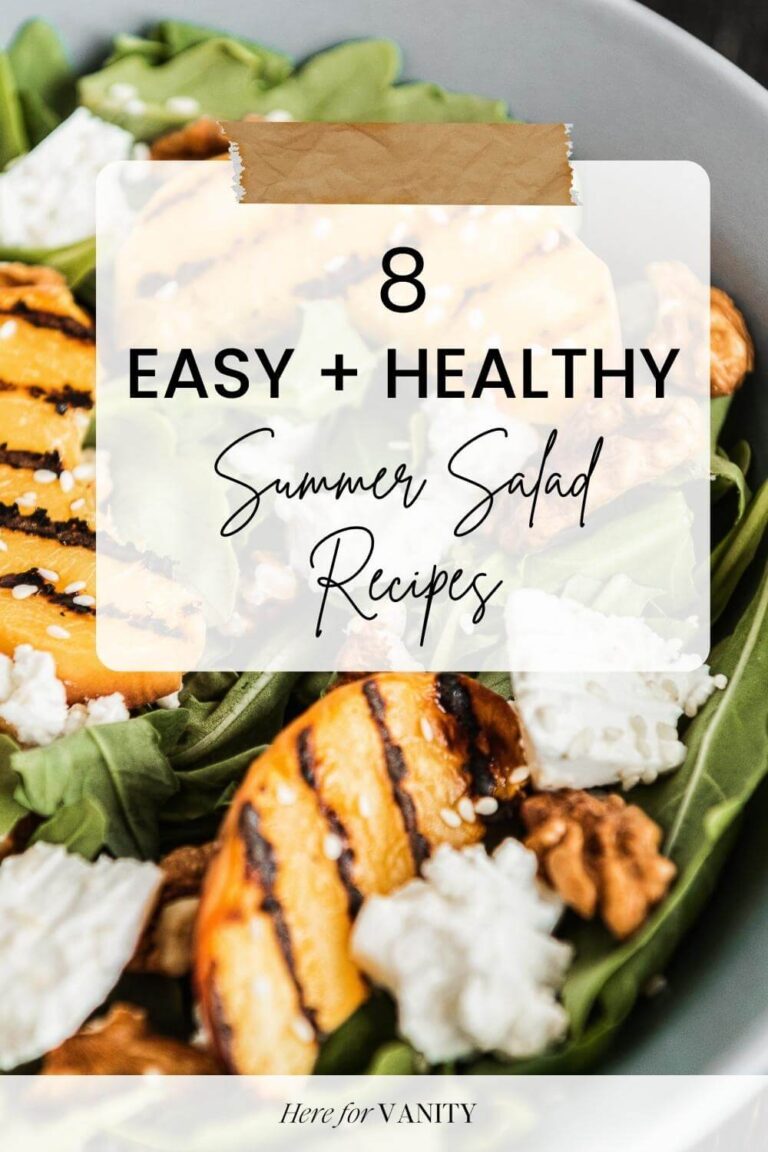The Best Macro-Friendly Grocery List For Anti-Aging
Looking for an easy, macro-friendly grocery list that won’t lead you toward processed, inflammatory foods? Look no further!
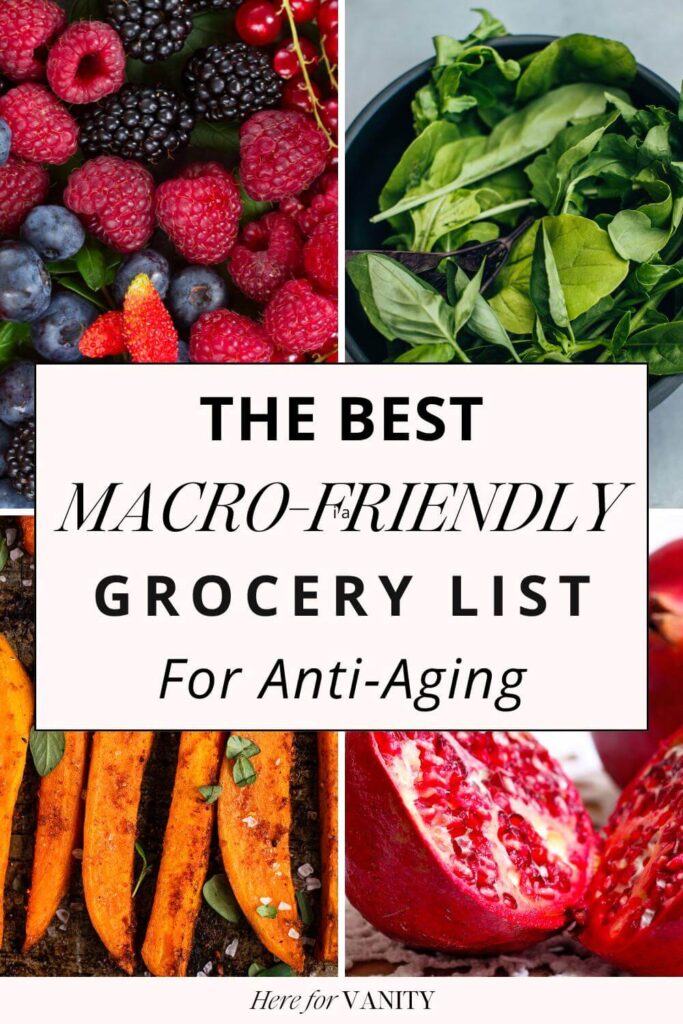
As much as I love macro-counting to stay in shape, it’s so easy to default to packaged or processed foods.
Let’s face it – fast food and packaged foods are easier to track because nutrition labels are readily available. But that’s not always the best choice for our health.
Back in the day, I could live off Quest bars and protein snacks and hit my macro goals. Now in my 40s, I know I feel and look my best when I eat a whole-foods-based diet.
In this post, we’ve created the best nutrient-rich, whole foods to help you hit your macros, including antioxidant-rich produce, quality proteins, and healthy fats – the essential building blocks of a balanced and youthful diet.
This post may contain affiliate links. This means I may earn a small commission if you purchase a product through my link at no extra cost to you. All items are carefully curated by me and reflect my honest opinion.
Understanding Macronutrients
Macronutrients, often called “macros,” are the three main components of our diet that provide energy and are essential for overall health and fitness. These macros include:
- Protein: Protein helps build and repair tissues, including muscles, bones, and skin. It also affects hormone production, enzyme function, and immune system support. Common protein sources include meat, poultry, fish, eggs, dairy products, legumes, nuts, and seeds.
- Carbohydrates: Carbs are the body’s primary source of energy, providing fuel for physical activity, brain function, and various metabolic processes. They come in two forms: simple carbohydrates (sugars) found in fruits, vegetables, and sweets, and complex carbohydrates (starches and fiber) found in grains, legumes, and starchy vegetables like potatoes.
- Fats: Fats are essential for maintaining cell structure, absorbing certain vitamins, and regulating hormone levels. They also provide a concentrated source of energy and support healthy brain function. Healthy fat sources include avocados, nuts, seeds, olive oil, fatty fish, and coconut oil.
What Are Macro-Friendly Foods?
Macro-friendly foods provide a balanced combination of macronutrients—protein, carbohydrates, and fats—while easily fitting within your daily calorie and macro targets.
When I consider something “macro-friendly,” it’s typically higher in protein, and I can easily add more or less of the food to adjust my macronutrient ratio to fit my goals.
These foods typically offer high nutritional value, keeping you satisfied and energized throughout the day. Examples include lean proteins like chicken breast or Greek yogurt, complex carbohydrates such as sweet potatoes and quinoa, and healthy fats like avocados and nuts.
Incorporating macro- and nutrient-rich foods into your diet is a great way to support your fitness goals.
What Are Anti-Aging Foods?
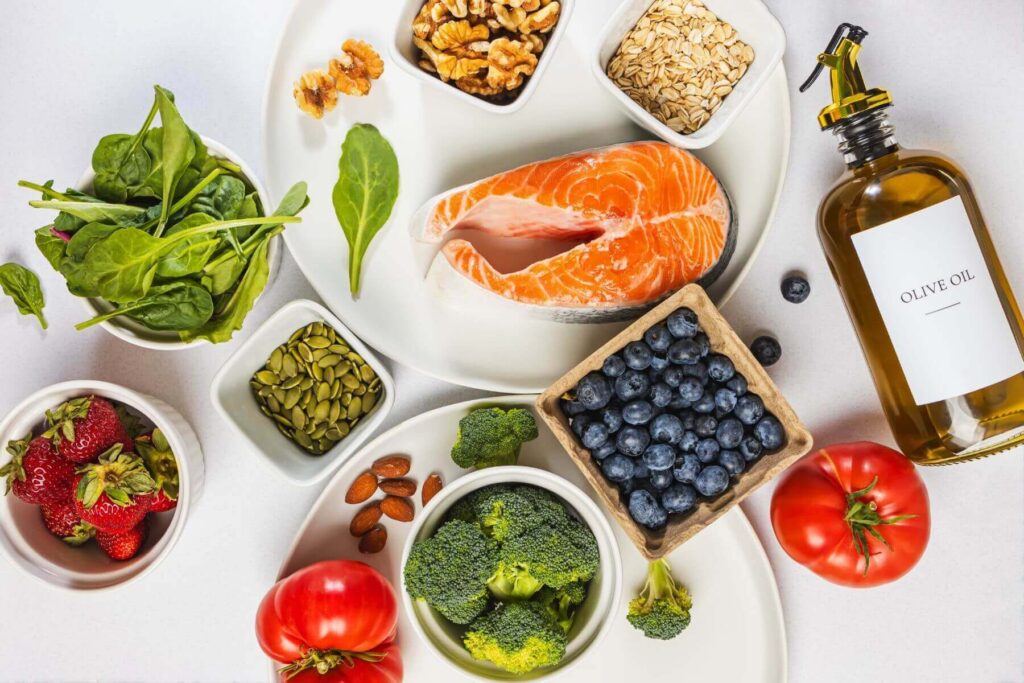
Anti-aging foods are loaded with antioxidants, vitamins, and nutrients that combat the effects of aging on your body and skin. Think whole, unprocessed foods that strengthen your body from the inside out. Adding anti-aging superfoods helps fight the signs of aging and gives you that radiant, glowing complexion.
In contrast, a typical “If It Fits Your Macros” (IIFYM) diet often leans heavily on processed and packaged foods to hit macro targets. While these foods may fit your daily calorie and macro goals, they usually lack the essential nutrients and antioxidants in whole, unprocessed foods.
Whole foods are superior for anti-aging because they provide a wide range of vitamins, minerals, and phytonutrients that support skin health, collagen production, and cellular repair.
By nourishing your body with nutrient-dense foods like fruits, vegetables, lean proteins, and healthy fats, you’ll help your skin stay firm, elastic, and youthful.
Additionally, anti-aging superfoods like berries, leafy greens, and fatty fish are rich in antioxidants that help neutralize free radicals and reduce oxidative stress, significant contributors to aging.
By adding these foods to your diet, you’re promoting skin health and supporting overall vitality and longevity.
So, in this macro-friendly grocery list, we’re skipping most processed snacks and opting for whole, nutrient-rich foods to keep our bodies running (and looking) optimally.
Related: The 12 Most Powerful Anti-Aging Superfoods for Women Over 40
How to Calculate and Track Macros
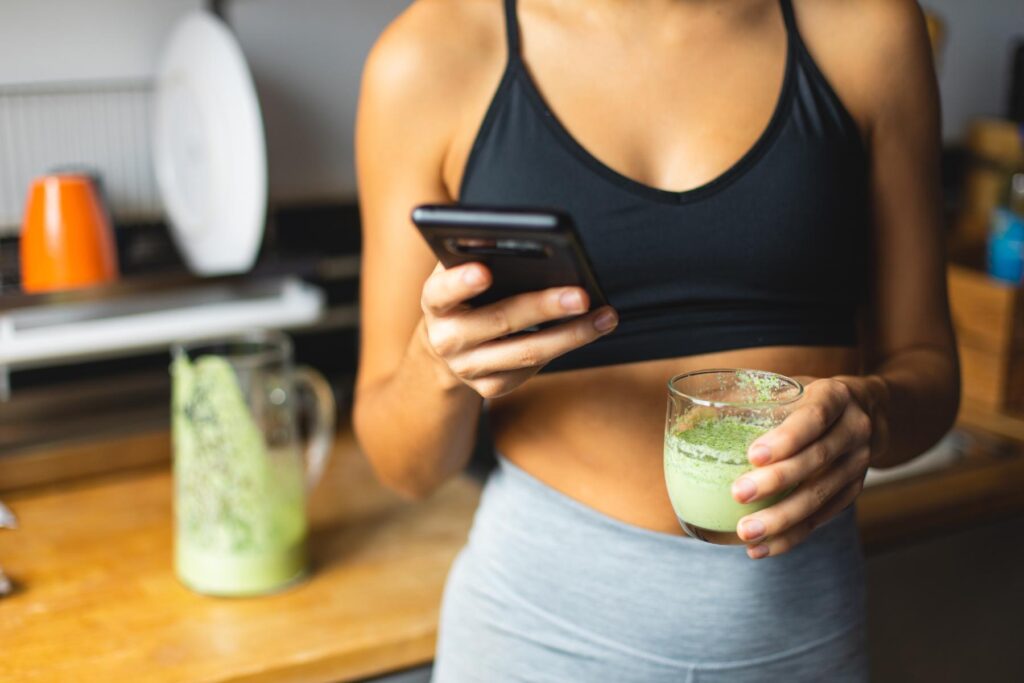
Counting macros, or macronutrients, involves tracking the amount of protein, carbohydrates, and fats you consume to meet specific fitness or health goals.
To start, determine your daily calorie and macronutrient targets based on your body composition goals.
For step-by-step instructions, read “How to Count Macros the Easy Way: Complete Beginner’s Guide.”
As a quick guide for establishing how many calories you need:
1. First, calculate your daily calorie needs to maintain your weight by taking your current weight and multiplying it by 13 if you lead a sedentary lifestyle, 15 if you exercise at least 30 minutes a few times per week, or 18 if you’re active five or more days per week.
If you weigh 140lbs, for example, and are generally sedentary, 1,820 calories a day will keep you the same weight (140lbs x 13 = 1,820)
2. Adjust the calories based on your composition goal. Want to lose weight? If you’re mostly sedentary, multiply your body weight by 10-12. Aim for 12-14 times your body weight for moderate activity, and for high activity levels, shoot for 14-16 times your body weight. This should provide a solid calorie range to target for weight loss.
To gain muscle mass, you’ll want to eat above your baseline calories to create a surplus.
For this example, 140 lbs x 12 (weight loss goal / sedentary) = 1,680 calories.
3. Calculate your protein macros. Protein is the primary macro we want to focus on. Aim for .8-1 gram per pound of body weight for protein.
So, if you’re 140 lbs, you’re looking at 140 grams of protein (give or take). Since protein has 4 calories per gram, 4×140=560 calories total. You now have 1,120 calories left to allocate to carbs and fats.
4. Determine your carb and fat macros. I like to go higher on fats because I prefer them over carbs, but you can do whatever your preference is. I’ll take 1,120 calories and multiply by 40%, giving me 448 calories.
Since fat has 9 calories per gram, I divide 448 calories by 9 and get 50 grams of fat.
We have 672 calories left, and since carbs are 4 calories per gram, 672/4 = 168 carbs.
Total macros are:
- 1,680 calories
- 140 grams of protein
- 50 grams of fat
- 168 grams of carbs
Alternatively, there are TONS of macro calculators online.
Here’s the thing, though: your starting macros are just a baseline. You’ll need to track your weight or body measurements weekly to see if you’re seeing your desired changes.
Record your meals and snacks using a food tracking app, like MyFitnessPal, to monitor your daily macro intake.
To keep it easy, focus on hitting your protein target, then adjust your carb and fat intake to stay within your overall calorie limit.
Ready to Transform Your Body in 8 Weeks?
Build muscle, lose fat, and feel stronger than ever by forming habits that last with the Fit Forever Method—start your journey today!
Benefits of Creating a Macro-Friendly Grocery List
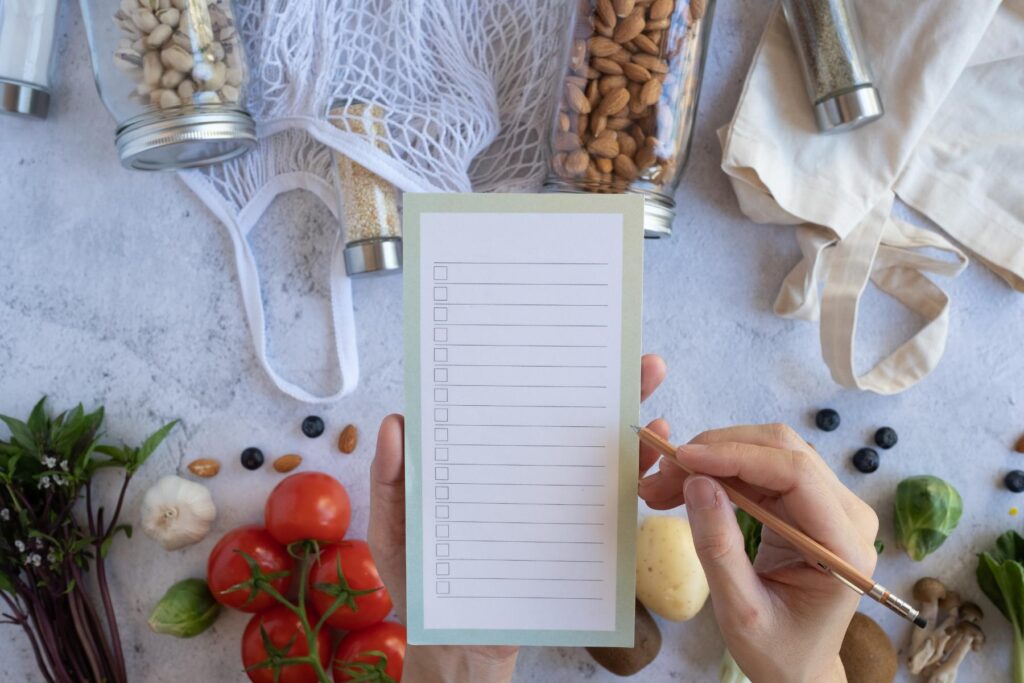
Want to know a sure-fire way to fail at a macro-based diet and feel like giving up entirely? By just tracking your food, hoping you reach your macros by the end of the day.
I’ve been there and had many days of needing to cram 40 grams of protein in at the end of the night because I didn’t plan out my meals. Ugh.
By thinking through your favorite go-to foods and pre-planning a few meal ideas, you’ll set yourself up for success.
A well-thought-out grocery list also helps you make healthier choices at the grocery store, reducing the temptation to impulse buy processed or unhealthy foods.
With a macro-based approach, you’ll also have greater flexibility and variety in your meals, making it easier to stick to your goals.
How to Build A Healthy, Macro-Friendly Grocery List
Instead of leaving our macro and calorie intake to chance, let’s take a proactive approach by loosely planning a few healthy meals and snacks ready to go.
Start by dividing your macros among the number of meals you typically eat in a day.
The beauty of counting macros is that your food timing doesn’t matter. As long as you consistently hit your macros daily, it doesn’t matter how or when you get them in.
Using the same example above, our macros are:
- 1,680 calories
- 140 grams of protein
- 50 grams of fat
- 168 grams of carbs
If you aim for three meals and two snacks daily, divide by five meals. This means each time you eat, you should aim for:
- 336 calories
- 28 grams of protein
- 10 grams of fat
- 33.6 grams of carbs
Each meal may vary slightly, but this is a good rough guideline.
Now, take a few moments to list out your favorite protein, carb, and fat sources with various meal combinations.
Each week, I like to pick 2 to 3 main proteins (like chicken and lean ground beef), 2 carbs (like potatoes and rice), and fat sources (olive oil for salad dressing, avocado, etc). I’ll prep as much as possible and use them in various meals throughout the week.
I can make quick salads, stir-fries, omelets, nourishing bowls, etc., by having my main ingredients prepped and ready.
Macro-Friendly Grocery List Staples
I love counting macros because they are flexible. You can incorporate anything into your diet if you balance it throughout the day.
As I get older, I appreciate high-quality foods that contribute to healthy aging and give me optimal energy levels throughout the day. Here are my go-to macro-friendly staple foods:
High-Quality Proteins

I opt for organic and grass-fed protein sources whenever possible, but this is entirely optional. You can still build a healthy, macro-friendly, anti-aging diet around non-organic foods.
- Organic Chicken Breast
- Organic Chicken Thigh
- Organic Pre-Made Rotisserie Chicken (such a time saver)
- Organic Ground Turkey
- Organic Turkey Breast
- Wild Salmon
- Wild Smoked Salmon
- Canned Tuna in Water
- White Fish (Mahi Mahi, Cod)
- Wild Shrimp
- Organic Pasture Raised Eggs
- Organic Egg Whites
- Organic Hard Boiled Eggs
- Grass Fed Beef
- Ground Bison
- Grass Fed Sirloin
- Organic Greek Yogurt
- Organic Ricotta
- Organic Cottage Cheese
- Clean Protein Powder (I like Sun Warrior Vegan Protein Powder)
- Collagen Peptides (My favorite is the Vital Proteins Collagen Powder)
Clean Carbs
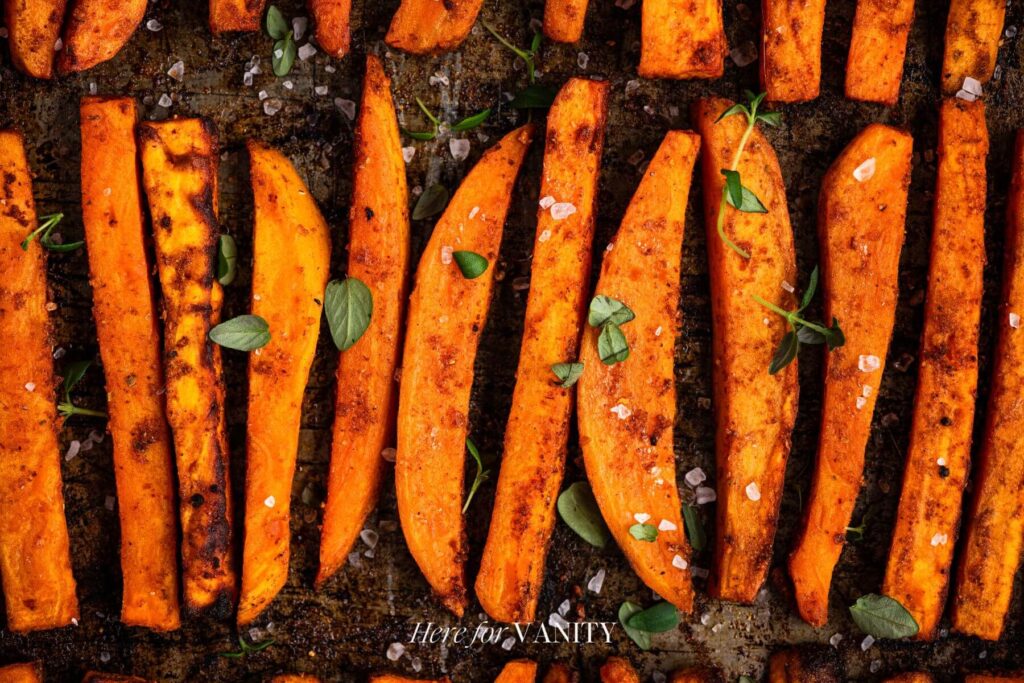
Carbs give us energy and fuel workouts. Don’t be afraid of carbs! It’s important to note that carbs can come from grains, fruits, and even candy. I build my “base” meals around whole grains and clean, simple carbs. Then, I leave a little room for a few fun snacks like rice cakes, tortilla chips, etc.
- Organic Oats
- Potatoes (all kinds)
- Beans and Legumes (all kinds)
- Rice (all kinds)
- Quinoa
- Sourdough Bread
- Ezekiel Bread
- Brown Rice Pasta
- Brown Rice Crackers (Mary’s Gone Crackers are my favorite)
- Plain Popcorn
- Siete Tortilla Chips
- Birch Benders Paleo Pancake Mix
- Plain Rice Cakes (I also love Quaker’s caramel rice cakes for a sweet treat)
- Fresh Berries
- Frozen Berries for Smoothies
- Pomegranate Seeds
- All Fruit
- Dried Fruit (no sugar added)
- Medjool Dates
- All Vegetables and Leafy Greens (negligible amount of carbs)
Nourishing Fats
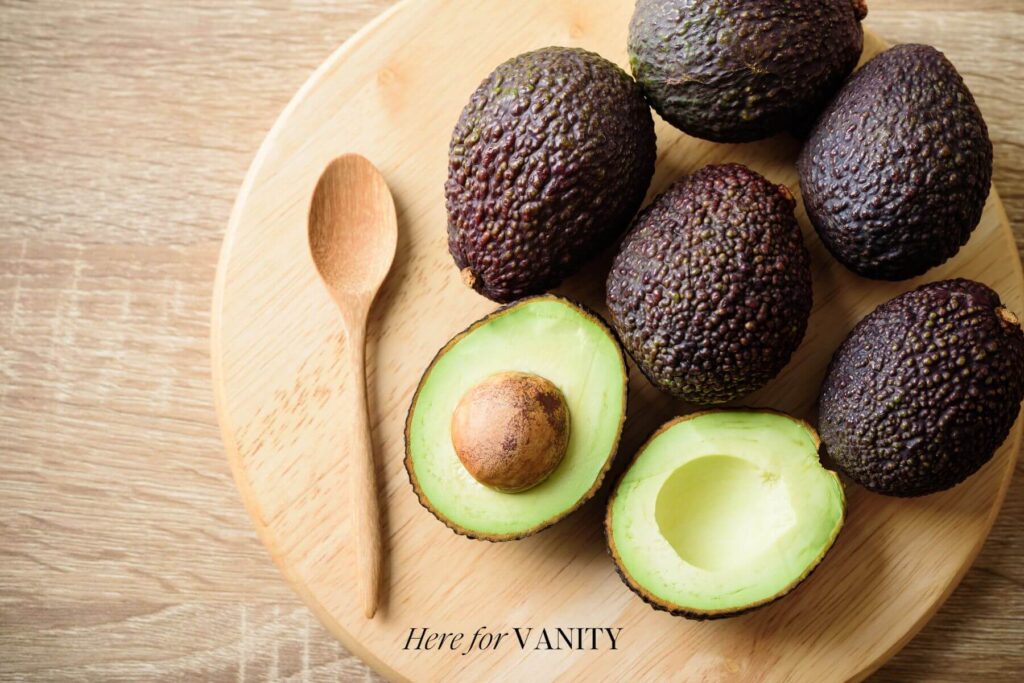
Incorporating healthy fats into a macro-based diet is essential for hormone balance, energy production, and satiety. These foods have the essential fatty acids to keep your hair, skin, and nails looking great, too.
- Avocados
- Olive Oil
- Avocado Oil
- Coconut Oil
- Olives
- Raw Parmesan Cheese
- Gress-fed Butter
- Organic Peanut Butter (Natural, no added sugar or oil)
- Organic Raw Almond Butter (Natural, no added sugar or oil)
- Walnuts
- Almonds
- Brazil Nuts
- Chia Seeds
- Pumpkin Seeds
- Hummus
- Dark Chocolate (Favorite Brand: HU Chocolate)
Extra Foods
Some other items that don’t quite fit into a macro but I like incorporating into my daily diet:
- Kimchi
- Sauerkraut
- Pickles
- Green Tea
- Organic Coffee
- Sparkling Water for Mocktails (Related: The Best Low-Sugar Mocktails With Guaranteed Anti-Aging Benefits)
- Lemons/Limes
- Honey
- Stevia
- Organic Maple Syrup
- Fresh herbs and spices
- Tumeric
- Ginger
Macro-Friendly Meals
Now that you have a solid list of food choices, begin picking your favorite foods and create meals based on your specific needs.
For meal planning, I choose a couple of proteins and carbohydrates and rotate fresh produce based on the season. I like to start with a high-protein selection and then layer in my carbs and fats.
Here are some great options for go-to balanced meals and snacks:
- Greek Yogurt + Berries + Chia Seeds
- Protein Overnight Oats: Greek Yogurt + Oats + Protein Powder
- Smoothie: Protein Powder + Yogurt + Berries + Greens
- Eggs + Ezekiel Bread + Nut Butter
- Chicken + Rice + Avocado + Kimchi
- Lean Ground Beef + Salad Mix + Rice + Avocado
- Grass Fed Beef Burger + Sweet Potato Fries + Salad with Olive Oil
- Grass Fed Beef + Roasted Potatoes + Green Beans
- Ground Turkey Meatballs + Rice + Mixed Vegetables
- Teriyaki Salmon + Rice + Edamame + Avocado
- Chicken + Orzo Rice + Feta Cheese + Greek Olives + Broccoli
- Cilantro Shrimp + Rice + Black Beans + Salad
Pick your favorite marinades or low calorie sauces, and you can create endless delicious meals.
Macro Diet Tools and Resources To Help You Stay On Track
Planning and preparation is the key to staying consistent and seeing results.
I’ve found that when I’m busy or fail to plan my meals, I tend to snack aimlessly and lose track of my macros for the day.
With over 15 years of experience counting macros, here are my favorite tools and strategies for staying on track.
- Macro Counting App: MyFitnessPal (free). I use the paid version, which gives you an ad-free experience and better tracking ability. The free version is great, though.
- Macro Calculator: I use this as a starting point and then adjust up or down after 2-3 weeks if I’m not seeing results.
- Food Scale: This is a must for tracking your portion sizes, especially in the beginning. Once you get used to your portion sizes, you can estimate. Accuracy is key if you’re serious about changing your body composition.
- Blender: A must-have for protein shakes, sauces, soups, and more.
- Meal Prep Containers: I love these for proportioning meals throughout the week. When I’m ready to eat, I grab a pre-made meal from the fridge – easy!
- Body Weight Scale: Nowadays, people say toss the scale away. I disagree. While I don’t obsess over the number, weighing myself daily and then averaging the weekly # tells me if I’m on track with my goals. It’s simply a consistent data point.
Building a macro-friendly grocery list for anti-aging is a simple way to fuel your body from the inside out. Stick with nutrient-dense foods packed with antioxidants, vitamins, and healthy fats to boost your fitness, health, and skin. Stay consistent, and you’ll see the results.
Pin This Macro-Friendly Grocery List for Later




